Marruecos
Download as ppt, pdf0 likes315 views
The document provides information about Morocco, including its language, religion, politics, climate, cities, and culture. It discusses the role of women, etiquette for greetings and dining. It highlights two important attractions - Asilah, a historic coastal city near Tangier dating back to 1500 BC, and Chellah Gardens in Rabat, which contains Roman ruins and tombstones within its Arabesque walls.
1 of 16
Download to read offline
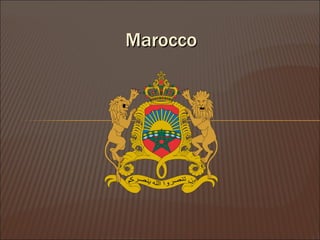
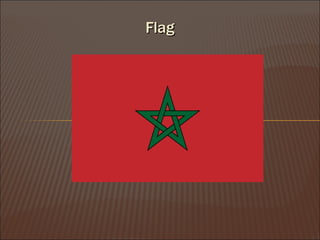
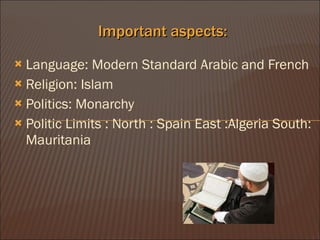
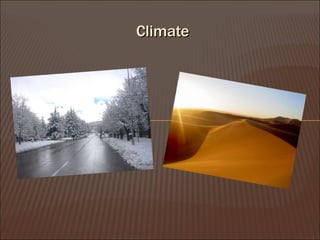
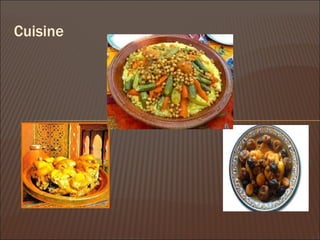
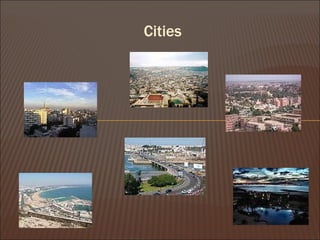
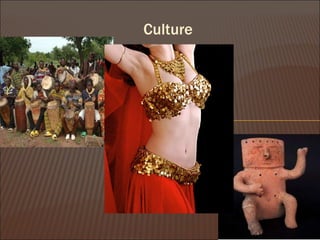
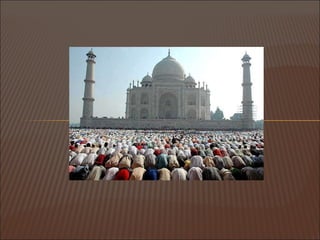
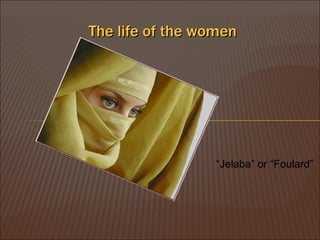
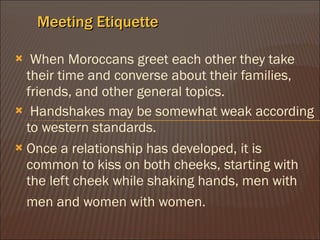
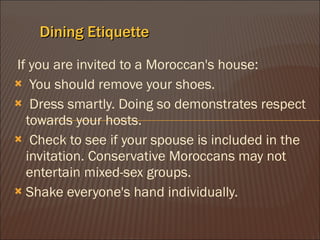

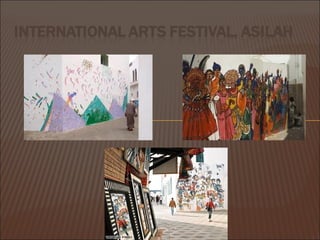
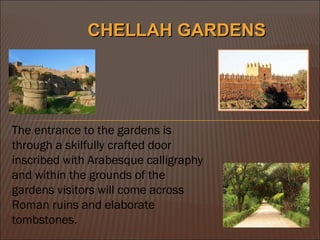
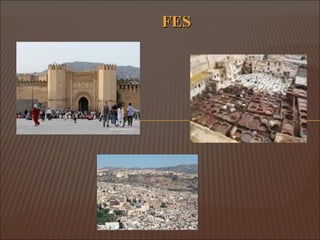
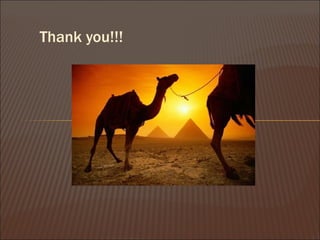
Ad
Recommended
Trips to morocco
Trips to moroccomarrakechweekend7
?
Morocco is a North African country known for its rich culture, history, and stable tourism industry, with its largest city being Casablanca. The official language is Arabic, but French is widely used in business, and the currency is the Moroccan dirham. The document promotes Marrakech Weekend, a company offering guided tours and excursions to showcase Morocco's diverse landscapes and heritage.Morocco presentation
Morocco presentationAyoub Rasdi
?
The document provides an overview of Morocco, highlighting its political regime, key cities, cuisine, famous personalities, and music. It details cities like Casablanca, Marrakech, Dakhla, Agadir, and Chefchaouen, describing their unique characteristics and cultural significance. Additionally, it mentions notable figures from Morocco, including Nadir Al-Khayat and Larbi Benbarek, and emphasizes the rich diversity of Moroccan music.Morocco
MoroccoAhu Erdo?du ALPASLAN
?
Morocco is a country in North Africa with coastlines on both the Atlantic Ocean and Mediterranean Sea. It has a population of over 33 million people and its largest cities are Casablanca and Rabat. Moroccan culture is a blend of Arab, Berber, African and European influences. Some aspects of Moroccan culture include traditional clothing like the djellaba robe, the practice of mint tea ceremonies, and wedding celebrations that can last several days and involve pre-marriage customs and ceremonies where the bride traditionally wears a decorated caftan dress.@Tim_Official: Il Customer care va su Twitter
@Tim_Official: Il Customer care va su TwitterLUCA BARTOLINI
?
Telecom Italia ha lanciato il servizio di customer care su Twitter, diventando la prima azienda in Italia a utilizzare i social media per l'assistenza clienti. Questo canale consente risposte rapide e un monitoraggio attivo delle opinioni dei clienti, migliorando l'efficienza rispetto ai tradizionali canali di assistenza. Inoltre, le interazioni su Twitter permettono una gestione pi©┤ riservata dei problemi, spostando le conversazioni pubbliche su messaggi diretti.Horario de parciales c©«mputo 3Oscar Roberto Bonilla Rodr©¬guez
?
Este documento presenta los horarios de parciales de tres carreras del Instituto Tecnol©«gico de Usulut©ón para la cuarta semana de noviembre. Incluye los d©¬as y horarios de los ex©ómenes parciales de T©”cnico en Ingenier©¬a en Computaci©«n, T©”cnico en Mantenimiento de PC, y C©«mputo 3 para las secciones I, II y M.Deepening our understanding of the professional learning cycle june 2011
Deepening our understanding of the professional learning cycle june 2011jaccalder
?
Educators should identify students' needs and determine which evidence-based teaching strategies to use to advance students' thinking and processing skills. The core of inquiry involves understanding students and choosing methods proven to move learning forward.Standar k3 02 operator
Standar k3 02 operatorSiswoyo Edo
?
Dokumen ini membahas peraturan menteri tenaga kerja No. 01/men/1989 tentang kualifikasi dan syarat operator keran angkat, termasuk dasar hukum, penggolongan, dan kewenangan operator. Terdapat rincian tentang syarat pelatihan, sertifikasi, serta kewajiban dan sanksi untuk operator. Selain itu, dokumen ini juga mengatur tentang ketentuan hukum dan aturan peralihan yang berlaku.AES, medir para mejorar (Estrategia & Negocios, Agosto 2016)AES El Salvador
?
El documento proporciona informaci©«n sobre varios pa©¬ses de Centroam©”rica. Resume algunas noticias clave sobre Honduras, Nicaragua y el cambio clim©ótico global. Tambi©”n describe las estrategias de gesti©«n de recursos humanos de AES, una compa?©¬a de energ©¬a que opera en varios pa©¬ses de Am©”rica Latina, incluyendo priorizar objetivos alineados, medir resultados y fomentar la comunicaci©«n y el desarrollo de liderazgo.Como abrir uma empresa no brasil pela amcham
Como abrir uma empresa no brasil pela amcham SDS MERIDIONAL GOIAS CORPORA??O
?
The document is a comprehensive guide on establishing a company in Brazil, sponsored by the American Chamber of Commerce for Brazil and Grant Thornton, highlighting Brazil's significance as a destination for foreign investment. It outlines the benefits of investing in Brazil, such as its growing middle class and strategic infrastructure opportunities, while detailing the necessary legal processes to incorporate a business, including selecting between different entity types like 'Limitada' or 'Sociedade An?nima'. Key aspects such as tax registration, hiring procedures, and compliance requirements are also emphasized to assist international companies in navigating the Brazilian business environment.Cafe0182 - Meer Online Rendement
Cafe0182 - Meer Online RendementWieger Waardenburg
?
Presentatie 23 maart 2011, Caf©”0182, Gouda
Tijdens de presentatie werd op hoofdlijnen ingegaan op online rendement. Daarbij staan de samenwerking tussen verschillende 'ingredi?nten' centraal.źßźżź¾źšźņ®`źÓż╬╣╣įņ└ĒĮŌ
źßźżź¾źšźņ®`źÓż╬╣╣įņ└ĒĮŌAtsushi Nakamoto
?
Il documento presenta una serie di simboli e caratteri non comprensibili, senza contenuto informativo chiaro. Non ©© possibile estrarre informazioni di alto livello a causa della sua formattazione illeggibile. Pertanto, non ©© fornito un riepilogo utile.Control de versiones y seguimientoMinisterio de Educacion
?
El documento explica c©«mo activar y usar las herramientas de control de versiones y seguimiento en Blackboard Learn. Para control de versiones, se debe activar la opci©«n al cargar un archivo y luego volver a cargar actualizaciones manteniendo el mismo nombre y extensi©«n. Esto crea un historial de versiones accesible desde el men©▓ contextual. Para seguimiento, tambi©”n se activa desde el men©▓ contextual y permite ver el historial de gesti©«n del archivo. Ambas herramientas ayudan a mantener versiones anteriores y registrar cambios.Using the Features API
Using the Features APIcgmonroe
?
The document outlines the Features API designed to capture and transfer module state information, allowing uniformity across servers. It explains terminology related to feature modules, component types, and the hooks involved in exporting, rendering, rebuilding, and reverting component states. A case study on the ldapauth module illustrates how to implement machine name support for settings transfer across servers using the API.????? ?????? ?? ???? ??????? ??????????
????? ?????? ?? ???? ??????? ??????????mohamed
?
?????? ??????? ????? ????? ?????? ?? ???? ??????? ??????????? ????? ??? ????? ????? ???????? ??????????? ?? ?????? ???????. ??? ???? ??? ??? ?????? ?? ??????? ????????? ??????? ?????? ??????? ????????? ?????? ???????? ??????. ???? ??????? ????? ????? ???????? ????????? ??????? ???????? ?? ????? ???????? ????? ???? ???????.Community case management: IRCĪ»s experience and considerations for scale up
Community case management: IRCĪ»s experience and considerations for scale upjehill3
?
The document discusses the experiences and lessons learned from IRC's community case management program, which trained community health workers to address common illnesses in children. Launched in 2005 with funding from the Canadian International Development Agency, the program aimed to reduce child mortality by treating approximately 1,500,000 children across six countries. Key insights include the importance of thorough training, effective supervision, and integrating efforts with government resources for sustainable scaling.HUERTO ECOL?GICO EN EL COLEGIO
HUERTO ECOL?GICO EN EL COLEGIO tapialoli
?
The document promotes creating presentations using Haiku Deck on ║▌║▌▀ŻShare. It features a stock photo and encourages the reader to get started making their own Haiku Deck presentation by clicking a button labeled "GET STARTED".¦▄¦┌¦┘¦ų¦▌¦Ó¦ė¦Ń¦▄¦┌¦█ ¦┘¦č¦ė¦Ó¦š
¦▄¦┌¦┘¦ų¦▌¦Ó¦ė¦Ń¦▄¦┌¦█ ¦┘¦č¦ė¦Ó¦šmagic59
?
¦ź¦Ó¦▄¦Õ¦▐¦ų¦▀¦õ ¦Ó¦ß¦┌¦Ń¦Ē¦ė¦č¦ų¦õ ¦ę¦┌¦ę¦▌¦┌¦Ó¦õ¦ų¦▄¦Õ ¦│¦ė¦±¦õ¦Ó-¦»¦┌¦▄¦Ó¦▌¦Ņ¦Ń¦▄¦Ó¦į¦Ó ¦ń¦Ō¦č¦▐¦č ¦ė ¦į¦Ó¦Ō¦Ó¦š¦ų ¦¼¦┌¦┘¦ų¦▌. ¦Ż ¦▀¦ų¦▐ ¦Õ¦ß¦Ó¦▐¦┌¦▀¦č¦¦õ¦Ń¦± ¦Ō¦ų¦Ń¦Õ¦Ō¦Ń¦Ē, ¦Õ¦Ń¦▌¦Õ¦į¦┌ ¦┌, ¦ė¦Ó¦┘¦▐¦Ó¦ž¦▀¦Ó, ¦▐¦ų¦Ō¦Ó¦ß¦Ō¦┌¦±¦õ¦┌¦ų, ¦Ń¦ė¦±¦┘¦č¦▀¦▀¦Ē¦ų ¦Ń ¦ę¦┌¦ę¦▌¦┌¦Ó¦õ¦ų¦▄¦Ó¦█. ¦░¦Ń¦▀¦Ó¦ė¦▀¦Ó¦ų ¦ė¦▀¦┌¦▐¦č¦▀¦┌¦ų ¦Õ¦š¦ų¦▌¦±¦ų¦õ¦Ń¦± ¦Ō¦Ó¦▌¦┌ ¦ę¦┌¦ę¦▌¦┌¦Ó¦õ¦ų¦▄¦┌ ¦▄¦č¦▄ ¦▄¦Õ¦▌¦Ņ¦õ¦Õ¦Ō¦▀¦Ó¦į¦Ó ¦┌ ¦Ó¦ę¦Ō¦č¦┘¦Ó¦ė¦č¦õ¦ų¦▌¦Ņ¦▀¦Ó¦į¦Ó ¦Ķ¦ų¦▀¦õ¦Ō¦č.Mobile Photography for Brands - A Case Study
Mobile Photography for Brands - A Case Study Michoel Ogince
?
The document discusses mobile photography for brands and presents a case study of a mobile marketing campaign by Disney Junior. It highlights how mobile and apps have become dominant, with social networks also being primarily mobile. A campaign by Disney Junior and Aviary aimed to promote two cartoons through a photo app that allowed users to add effects, frames and stickers. The app drove significant exposure, engagement and installs. The case study demonstrated how a native mobile experience leveraging a brand's audience can be an effective marketing strategy.2012 Social Technology Forecast
2012 Social Technology ForecastMichoel Ogince
?
This document provides a 2012 social technology forecast from Big Fuel's Director of Product & Platform Strategy. It summarizes four key trends: 1) social technologies moving towards more humanized interactions that simulate real social behavior; 2) the growth of open graph objects that attach content and products to social profiles; 3) the emergence of social commerce platforms integrating e-commerce into social networks; and 4) the rapid growth of the image-sharing site Pinterest and opportunities for brands.Social Media - tips en de basis
Social Media - tips en de basisWieger Waardenburg
?
Presentatie Social Media, 8 december 2010 VACO congres Utrecht000267 pterygium and_topical_bevacizumab
000267 pterygium and_topical_bevacizumabDr. Anand Sudhalkar
?
Topical bevacizumab in combination with flurbiprofen eye drops and punctal occlusion for 4 weeks after pterygium excision and conjunctival autograft showed no recurrence of pterygium in any of the 17 patients over a 2 year follow up period. No patients experienced any ocular or systemic side effects from the topical bevacizumab treatment. This prospective case series suggests that topical bevacizumab may be a safe and effective adjuvant therapy to prevent recurrence of primary pterygium after surgery. Larger controlled studies are still needed.2011 worldfootwearyearbook
2011 worldfootwearyearbookCarlos Maculan
?
Production and trade of footwear is heavily concentrated in Asia. In 2010:
- Asia produced 87% of the world's footwear, led by China at 62%.
- Asia exported 85% of the world's footwear, with China responsible for 73%.
- The average export price from Asia was around $4, compared to $23 from Europe.PSI Diarrhea Prevention and Safe Water Approaches
PSI Diarrhea Prevention and Safe Water Approaches jehill3
?
Unsafe water and lack of sanitation are major global problems, contributing to over 1.5 million child deaths from diarrhea each year. Household water treatment (HWT) options like sodium hypochlorite, Aquatabs, and PUR can provide low-cost solutions, treating water for a family of 6 for less than a penny per day. Social marketing approaches that combine communications and product access have helped programs in over 30 countries treat over 60 billion liters of water, improving health behaviors and reducing diarrhea prevalence in places like Madagascar. Lessons show that focusing on key behavior drivers, partnerships, and multiple communication channels can enable HWT to effectively and affordably scale up safe water access.Information for tourists Visiting Morocco
Information for tourists Visiting MoroccoMatt Reid
?
This document provides information for tourists visiting Morocco, including:
- Morocco has a variety of landscapes from ancient cities to deserts and mountains.
- Health precautions like drinking bottled water and getting travel insurance are recommended.
- Local customs like modest dress codes, avoiding public alcohol consumption, and not photographing without permission should be followed.
- Major cities and sights, average temperatures, currency, and Friday prayer times are outlined.Morocco
Moroccomeganbedford
?
Morocco is located in Northwest Africa, bordering the Atlantic Ocean and Mediterranean Sea. The majority of the country is mountainous, with the Atlas Mountains running through the center and south and the Rif Mountains in the north. Morocco's capital is Rabat and largest city is Casablanca. Arabic and Berber are the most common languages, though French also has influence. Islam is the dominant religion and influences many cultural aspects of Moroccan life. Traditional Moroccan culture centers around souks, tagines, mint tea, and respecting customs regarding homes, mosques, photography, and gender roles. Morocco has a long history with influences from Roman rule and Islamic expansion before becoming a French protectorate in theMore Related Content
Viewers also liked (20)
Como abrir uma empresa no brasil pela amcham
Como abrir uma empresa no brasil pela amcham SDS MERIDIONAL GOIAS CORPORA??O
?
The document is a comprehensive guide on establishing a company in Brazil, sponsored by the American Chamber of Commerce for Brazil and Grant Thornton, highlighting Brazil's significance as a destination for foreign investment. It outlines the benefits of investing in Brazil, such as its growing middle class and strategic infrastructure opportunities, while detailing the necessary legal processes to incorporate a business, including selecting between different entity types like 'Limitada' or 'Sociedade An?nima'. Key aspects such as tax registration, hiring procedures, and compliance requirements are also emphasized to assist international companies in navigating the Brazilian business environment.Cafe0182 - Meer Online Rendement
Cafe0182 - Meer Online RendementWieger Waardenburg
?
Presentatie 23 maart 2011, Caf©”0182, Gouda
Tijdens de presentatie werd op hoofdlijnen ingegaan op online rendement. Daarbij staan de samenwerking tussen verschillende 'ingredi?nten' centraal.źßźżź¾źšźņ®`źÓż╬╣╣įņ└ĒĮŌ
źßźżź¾źšźņ®`źÓż╬╣╣įņ└ĒĮŌAtsushi Nakamoto
?
Il documento presenta una serie di simboli e caratteri non comprensibili, senza contenuto informativo chiaro. Non ©© possibile estrarre informazioni di alto livello a causa della sua formattazione illeggibile. Pertanto, non ©© fornito un riepilogo utile.Control de versiones y seguimientoMinisterio de Educacion
?
El documento explica c©«mo activar y usar las herramientas de control de versiones y seguimiento en Blackboard Learn. Para control de versiones, se debe activar la opci©«n al cargar un archivo y luego volver a cargar actualizaciones manteniendo el mismo nombre y extensi©«n. Esto crea un historial de versiones accesible desde el men©▓ contextual. Para seguimiento, tambi©”n se activa desde el men©▓ contextual y permite ver el historial de gesti©«n del archivo. Ambas herramientas ayudan a mantener versiones anteriores y registrar cambios.Using the Features API
Using the Features APIcgmonroe
?
The document outlines the Features API designed to capture and transfer module state information, allowing uniformity across servers. It explains terminology related to feature modules, component types, and the hooks involved in exporting, rendering, rebuilding, and reverting component states. A case study on the ldapauth module illustrates how to implement machine name support for settings transfer across servers using the API.????? ?????? ?? ???? ??????? ??????????
????? ?????? ?? ???? ??????? ??????????mohamed
?
?????? ??????? ????? ????? ?????? ?? ???? ??????? ??????????? ????? ??? ????? ????? ???????? ??????????? ?? ?????? ???????. ??? ???? ??? ??? ?????? ?? ??????? ????????? ??????? ?????? ??????? ????????? ?????? ???????? ??????. ???? ??????? ????? ????? ???????? ????????? ??????? ???????? ?? ????? ???????? ????? ???? ???????.Community case management: IRCĪ»s experience and considerations for scale up
Community case management: IRCĪ»s experience and considerations for scale upjehill3
?
The document discusses the experiences and lessons learned from IRC's community case management program, which trained community health workers to address common illnesses in children. Launched in 2005 with funding from the Canadian International Development Agency, the program aimed to reduce child mortality by treating approximately 1,500,000 children across six countries. Key insights include the importance of thorough training, effective supervision, and integrating efforts with government resources for sustainable scaling.HUERTO ECOL?GICO EN EL COLEGIO
HUERTO ECOL?GICO EN EL COLEGIO tapialoli
?
The document promotes creating presentations using Haiku Deck on ║▌║▌▀ŻShare. It features a stock photo and encourages the reader to get started making their own Haiku Deck presentation by clicking a button labeled "GET STARTED".¦▄¦┌¦┘¦ų¦▌¦Ó¦ė¦Ń¦▄¦┌¦█ ¦┘¦č¦ė¦Ó¦š
¦▄¦┌¦┘¦ų¦▌¦Ó¦ė¦Ń¦▄¦┌¦█ ¦┘¦č¦ė¦Ó¦šmagic59
?
¦ź¦Ó¦▄¦Õ¦▐¦ų¦▀¦õ ¦Ó¦ß¦┌¦Ń¦Ē¦ė¦č¦ų¦õ ¦ę¦┌¦ę¦▌¦┌¦Ó¦õ¦ų¦▄¦Õ ¦│¦ė¦±¦õ¦Ó-¦»¦┌¦▄¦Ó¦▌¦Ņ¦Ń¦▄¦Ó¦į¦Ó ¦ń¦Ō¦č¦▐¦č ¦ė ¦į¦Ó¦Ō¦Ó¦š¦ų ¦¼¦┌¦┘¦ų¦▌. ¦Ż ¦▀¦ų¦▐ ¦Õ¦ß¦Ó¦▐¦┌¦▀¦č¦¦õ¦Ń¦± ¦Ō¦ų¦Ń¦Õ¦Ō¦Ń¦Ē, ¦Õ¦Ń¦▌¦Õ¦į¦┌ ¦┌, ¦ė¦Ó¦┘¦▐¦Ó¦ž¦▀¦Ó, ¦▐¦ų¦Ō¦Ó¦ß¦Ō¦┌¦±¦õ¦┌¦ų, ¦Ń¦ė¦±¦┘¦č¦▀¦▀¦Ē¦ų ¦Ń ¦ę¦┌¦ę¦▌¦┌¦Ó¦õ¦ų¦▄¦Ó¦█. ¦░¦Ń¦▀¦Ó¦ė¦▀¦Ó¦ų ¦ė¦▀¦┌¦▐¦č¦▀¦┌¦ų ¦Õ¦š¦ų¦▌¦±¦ų¦õ¦Ń¦± ¦Ō¦Ó¦▌¦┌ ¦ę¦┌¦ę¦▌¦┌¦Ó¦õ¦ų¦▄¦┌ ¦▄¦č¦▄ ¦▄¦Õ¦▌¦Ņ¦õ¦Õ¦Ō¦▀¦Ó¦į¦Ó ¦┌ ¦Ó¦ę¦Ō¦č¦┘¦Ó¦ė¦č¦õ¦ų¦▌¦Ņ¦▀¦Ó¦į¦Ó ¦Ķ¦ų¦▀¦õ¦Ō¦č.Mobile Photography for Brands - A Case Study
Mobile Photography for Brands - A Case Study Michoel Ogince
?
The document discusses mobile photography for brands and presents a case study of a mobile marketing campaign by Disney Junior. It highlights how mobile and apps have become dominant, with social networks also being primarily mobile. A campaign by Disney Junior and Aviary aimed to promote two cartoons through a photo app that allowed users to add effects, frames and stickers. The app drove significant exposure, engagement and installs. The case study demonstrated how a native mobile experience leveraging a brand's audience can be an effective marketing strategy.2012 Social Technology Forecast
2012 Social Technology ForecastMichoel Ogince
?
This document provides a 2012 social technology forecast from Big Fuel's Director of Product & Platform Strategy. It summarizes four key trends: 1) social technologies moving towards more humanized interactions that simulate real social behavior; 2) the growth of open graph objects that attach content and products to social profiles; 3) the emergence of social commerce platforms integrating e-commerce into social networks; and 4) the rapid growth of the image-sharing site Pinterest and opportunities for brands.Social Media - tips en de basis
Social Media - tips en de basisWieger Waardenburg
?
Presentatie Social Media, 8 december 2010 VACO congres Utrecht000267 pterygium and_topical_bevacizumab
000267 pterygium and_topical_bevacizumabDr. Anand Sudhalkar
?
Topical bevacizumab in combination with flurbiprofen eye drops and punctal occlusion for 4 weeks after pterygium excision and conjunctival autograft showed no recurrence of pterygium in any of the 17 patients over a 2 year follow up period. No patients experienced any ocular or systemic side effects from the topical bevacizumab treatment. This prospective case series suggests that topical bevacizumab may be a safe and effective adjuvant therapy to prevent recurrence of primary pterygium after surgery. Larger controlled studies are still needed.2011 worldfootwearyearbook
2011 worldfootwearyearbookCarlos Maculan
?
Production and trade of footwear is heavily concentrated in Asia. In 2010:
- Asia produced 87% of the world's footwear, led by China at 62%.
- Asia exported 85% of the world's footwear, with China responsible for 73%.
- The average export price from Asia was around $4, compared to $23 from Europe.PSI Diarrhea Prevention and Safe Water Approaches
PSI Diarrhea Prevention and Safe Water Approaches jehill3
?
Unsafe water and lack of sanitation are major global problems, contributing to over 1.5 million child deaths from diarrhea each year. Household water treatment (HWT) options like sodium hypochlorite, Aquatabs, and PUR can provide low-cost solutions, treating water for a family of 6 for less than a penny per day. Social marketing approaches that combine communications and product access have helped programs in over 30 countries treat over 60 billion liters of water, improving health behaviors and reducing diarrhea prevalence in places like Madagascar. Lessons show that focusing on key behavior drivers, partnerships, and multiple communication channels can enable HWT to effectively and affordably scale up safe water access.Similar to Marruecos (20)
Information for tourists Visiting Morocco
Information for tourists Visiting MoroccoMatt Reid
?
This document provides information for tourists visiting Morocco, including:
- Morocco has a variety of landscapes from ancient cities to deserts and mountains.
- Health precautions like drinking bottled water and getting travel insurance are recommended.
- Local customs like modest dress codes, avoiding public alcohol consumption, and not photographing without permission should be followed.
- Major cities and sights, average temperatures, currency, and Friday prayer times are outlined.Morocco
Moroccomeganbedford
?
Morocco is located in Northwest Africa, bordering the Atlantic Ocean and Mediterranean Sea. The majority of the country is mountainous, with the Atlas Mountains running through the center and south and the Rif Mountains in the north. Morocco's capital is Rabat and largest city is Casablanca. Arabic and Berber are the most common languages, though French also has influence. Islam is the dominant religion and influences many cultural aspects of Moroccan life. Traditional Moroccan culture centers around souks, tagines, mint tea, and respecting customs regarding homes, mosques, photography, and gender roles. Morocco has a long history with influences from Roman rule and Islamic expansion before becoming a French protectorate in theInformation for tourists Visiting Morocco
Information for tourists Visiting MoroccoMatt Reid
?
Morocco is a diverse country with a slower pace of life compared to Western nations. It has many contrasts from ancient cities to deserts and mountains. Some key tips for visitors include drinking only bottled water, having travel insurance, avoiding drugs and public intoxication, respecting local customs like modest dress for women, and not wandering alone in remote areas like the Sahara desert. Photography etiquette requires permission before photographing people and avoiding sensitive locations like mosques.Morocco People and Places
Morocco People and PlacesPyramid Connections
?
Morocco and Turkey are two of the best places to visit in the Muslim world for several reasons: they are located at the crossroads of two continents, have rich histories and cultures, and great food. Morocco in particular has over 36 million residents and its largest cities are Casablanca and Rabat. It has a diverse landscape that includes the Atlas Mountains and Sahara Desert. Morocco also has a long history dating back to Arab conquest in the 700s-800s and was a French protectorate until independence in 1956. It has a majority Sunni Muslim population and Arabic and Berber are the main languages. The oldest continually operating university, Al-Qarawiyyin, is located in the city ofWho are the Tuareg
Who are the Tuaregamonyhig .
?
The document provides information about the Tuareg people, including:
- They live in parts of Niger, Nigeria, Burkina Faso, Senegal, and Mali.
- For thousands of years, their economy revolved around trans-Saharan trade routes, bringing goods from southern cities in Africa to northern Mediterranean coasts.
- While most Tuareg now practice Islam, they are not considered Arabic. Their practice of Islam is often nominal, following some rituals but not strictly adhering to requirements like fasting during Ramadan due to their nomadic lifestyle.Lifestyle and traveling in Morocco
Lifestyle and traveling in Morocco peter951197
?
Morocco features a unique blend of Arabic, French, and Spanish cultures, with Berbers as the indigenous people. The country is predominantly Sunni Muslim, celebrating religious events like moussems and festivals that foster cultural exchange. Moroccan customs emphasize modesty in clothing and strong hospitality, while music and sports play significant roles in the nation's vibrant lifestyle.[?PDF?] Algeria Is Beautiful like America Ipad
[?PDF?] Algeria Is Beautiful like America Ipadjaimehansen9
?
Algeria offers a variety of landscapes from coastal cities to the vast Sahara desert. The capital Algiers features a well-preserved whitewashed medina called the Casbah. The port city of Oran shows French colonial influences in its architecture. Four-fifths of Algeria is covered by the Sahara desert, home to nomadic Berber tribes and prehistoric rock art sites. While political instability has deterred some visitors, organized tours allow travelers to explore the desert's remote areas and annual film festivals highlight the culture.Culture of Morocco
Culture of Morocco Anas Ziane
?
The document presents a comprehensive overview of Morocco, detailing its geography, culture, history, and societal norms, including the diverse ethnic groups such as Arabs and Berbers, as well as the influence of Islam. It explores key aspects like the country's climate, languages, and artistic traditions while contrasting cultural differences between Morocco and China in business practices and social interactions. Additionally, it touches on Morocco's constitutional monarchy, significant holidays, and the long-standing diplomatic relationship with China.South Africa.pptx
South Africa.pptxJloGanda
?
This document provides information about several countries in southern Africa, including their populations, areas, climates, religions, and capital cities. It then focuses on details for specific countries. For South Africa, it discusses the family structure, differences between rural and urban areas, and etiquette for meetings, gifts, dining, and business. For Angola, it describes the major ethnic groups and spirit worship traditions, as well as etiquette. For Namibia, it discusses family culture, society, wedding traditions, and business and meeting etiquette. It also provides brief descriptions of notable cities and sites in South Africa, Angola, and Namibia.A Topical Overview Of Rapid Secrets In Riad In Marrakech Private Pool
A Topical Overview Of Rapid Secrets In Riad In Marrakech Private Pool
janifamarrakech94
?
The document provides an overview of Marrakech, highlighting its rich cultural heritage, tourism challenges, and the complexities of Moroccan society and government. It discusses the varied experiences of tourists, including local cuisine and interactions, while also touching on economic and political issues affecting the region. Additionally, it mentions the contrasting aspects of ancient traditions and modern influences in the city.Aiesec morocco reception booklet
Aiesec morocco reception bookletAIESEC India
?
Morocco's culture reflects influences from Carthaginians, Romans, French, Spanish, and Arabs. Hospitality is essential to Moroccan culture, and the diverse population includes Berbers, Arabs, Jews, Muslims, Africans, and Europeans. The document provides an overview of Morocco's climate, festivals, cuisine, languages, and practical travel information. It summarizes transportation options, safety tips, etiquette on photography and dress, and includes basic phrases to use. Contact information is given for AIESEC Morocco leaders who can provide more details on opportunities for young visitors.Practical Ideas On Simple Solutions In Luxury Holidays To
Practical Ideas On Simple Solutions In Luxury Holidays To
itchymishap1400
?
The document discusses the allure of Morocco as a luxury holiday destination, emphasizing its unique culture, cuisine, and historical significance. It highlights the transition of Morocco into a popular travel spot, despite challenges such as unemployment and social issues. The document also touches upon the impact of external influences, including European interaction and the rise of tourism-related facilities in the region.Tuareg
TuaregDarron Gray
?
The Tuareg people number around 5.2 million living primarily in Niger, Mali, Algeria, Burkina Faso, and Libya. They are traditionally nomadic herders who wear distinctive blue or black veils and live in tents. The Tuareg society was historically divided between pastoralists and farmers, and they have resisted full adoption of Islam while integrating some rituals and holidays. Their staple foods include milk, porridge, bread, and cheeses from goats.The Latest Insights Into Choosing Issues In Quad Biking Marrakech
The Latest Insights Into Choosing Issues In Quad Biking Marrakech
wretchedgun3301
?
The document provides information about tourism in Morocco, including details about hotels, architecture, and activities. It mentions riads, which are houses converted from ruins with gardens, and recommends hotels in Fez like Pasha Baghdadi Massriya and in Marrakech like Hotel Ali and Kasbah Agafay. It also notes the natural beauty of Morocco and activities like camel treks that attract tourists from around the world.Afro Tourism Brochure 2015
Afro Tourism Brochure 2015 Kelechi Ordu-Obuah
?
The document is about a travel media and publishing company that showcases Africa as a dynamic travel destination, highlighting its untapped potential, cultural diversity, adventure opportunities, and exquisite cuisine. It provides a wealth of information about African cities, attractions, and experiences while promoting customized travel packages and a mobile-friendly website full of travel tips. The company aims to expose unique, lesser-known travel experiences and connect travelers with local tourism services across the continent.algeria.pptx
algeria.pptxbenghalemmalek
?
This document provides an overview of the education system in Algeria. It details the main levels of education including primary, lower secondary, upper secondary, vocational secondary, higher vocational, tertiary education and doctorate levels. The typical ages and duration of each level is outlined along with some of the qualifications obtained such as the Baccalaureate. Vocational pathways are also described in addition to the general academic routes.Locating Speedy Strategies In Three Palms Hotel Riad El Bacha Marrakech
Locating Speedy Strategies In Three Palms Hotel Riad El Bacha Marrakech
wofiberiad50
?
The document provides an overview of travel experiences in Marrakech, Morocco, including hotel options, local attractions, and cultural insights. It highlights the popularity of various regions such as Agadir and the significance of Moroccan cuisine and architecture. Additionally, it discusses ongoing political and social dynamics in Morocco, touching upon tourism and cultural engagement.Tuareg presentation
Tuareg presentationDrew Ralston
?
The document provides an overview of the Tuareg people, including their ancestry, where they live, and their relationship with surrounding countries and groups like AQIM. Some key points:
- The Tuareg are a nomadic Berber group living in the Sahara region of North Africa, primarily in Mali, Niger and Algeria.
- They have a long history of rebellion against governments for discrimination and mistreatment of Berber peoples. Many Tuareg fought for Gaddafi in Libya.
- In 2012, Tuareg rebels in Mali declared independence but were soon pushed aside by better armed Islamist groups like Ansar Dine who sought to impose sharia law.
- There isAfrican cultures
African culturesKhurram Sehzad
?
The document provides an overview of African culture, highlighting its diversity through historical context, arts and crafts, folklore, and cuisine. It discusses the political and racial divisions between North and Sub-Saharan Africa and emphasizes how colonialism has impacted cultural identity. Additionally, the document covers music and languages spoken across the continent, showcasing the rich tapestry of traditions and influences that define African culture.DBI_Morocco_aug2011_final_WEB.pdf
DBI_Morocco_aug2011_final_WEB.pdfYOUFFOU1
?
Morocco offers several advantages for international business including a well-educated workforce, business friendly laws and regulations, political stability, and good infrastructure. This guide provides an overview of key considerations for doing business in Morocco such as business organization, taxation, employment laws, auditing, intellectual property rights, and living in Morocco. It aims to help businesses understand the requirements for setting up and ensuring compliance in Morocco, though specific professional advice is also recommended.Ad
Marruecos
- 1. Marocco
- 2. Flag
- 3. Important aspects: Language: Modern Standard Arabic and French Religion: Islam Politics: Monarchy Politic Limits : North : Spain East :Algeria South: Mauritania
- 4. Climate
- 5. Cuisine
- 6. Cities
- 7. Culture
- 8. ?
- 9. The life of the women Ī░ JelabaĪ▒ or Ī░FoulardĪ▒
- 10. Meeting Etiquette ? When Moroccans greet each other they take their time and converse about their families, friends, and other general topics. ? Handshakes may be somewhat weak according to western standards. Once a relationship has developed, it is common to kiss on both cheeks, starting with the left cheek while shaking hands, men with men and women with women.
- 11. Dining Etiquette If you are invited to a Moroccan's house: ? You should remove your shoes. ? Dress smartly. Doing so demonstrates respect towards your hosts. ? Check to see if your spouse is included in the invitation. Conservative Moroccans may not entertain mixed-sex groups. Shake everyone's hand individually.
- 12. Asilah , also known as Arzila. , is one of the most pictures and historic attractions in Morocco . It is located approximately fifty kilometers outside the city of Tangier and has been dated back to 1500 B.C. Asilah
- 13. ?
- 14. The entrance to the gardens is through a skilfully crafted door inscribed with Arabesque calligraphy and within the grounds of the gardens visitors will come across Roman ruins and elaborate tombstones. CHELLAH GARDENS
- 15. FES
- 16. Thank you!!!